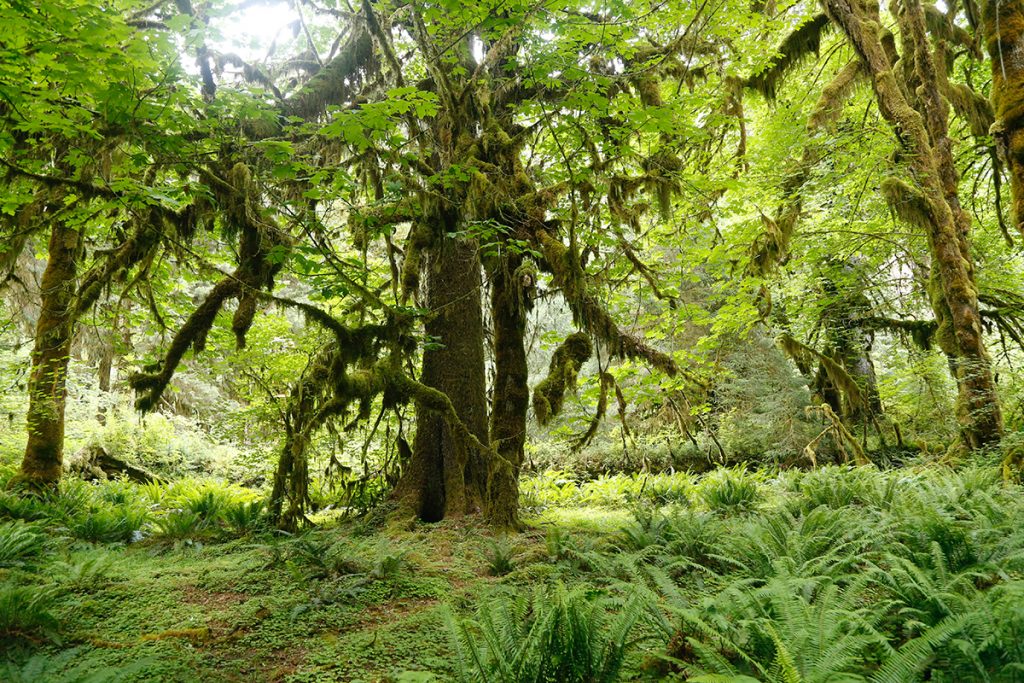- 1. Hike into the Mountains
- 1.1. Hurricane Ridge Trail to Hurricane Hill
- 1.2. Sunrise Ridge to Sunrise Point Trail
- 1.3. Klahhane Ridge Trail to Mount Angeles
- 1.4. Mount Ellinor Trail
- 1.5. Obstruction Point Road
- 2. Explore Hoh Rain Forest
- 3. View the Waterfalls
- 3.1. Marymere Falls
- 3.2. Sol Duc Falls
- 3.3. Royal Basin Falls
- 4. Spend Time Around the Lakes and Rivers
- 5. Bike the Olympic Discovery Trail
- 6. Visit the Pacific Coastline
- 6.1. Cape Flattery
- 6.2. Shi Shi Beach
- 6.3. Rialto Beach
- 6.4. Cape Alava Loop
- 6.5. La Push Beaches
- 6.6. Ruby Beach
- 6.7. Kalaloch
- 7. Go Backpacking
- 7.1. Enchanted Valley
- 7.2. Seven Lakes Basin Loop (High Divide)
- 7.3. Pacific Coast Wilderness
- 8. Stargazing is a Must
- 9. Where to Stay in Olympic National Forest
- 9.1. Port Angeles
- 9.2. Forks
- 9.3. Campgrounds
- 10. Embark On an Adventure With KÜHL
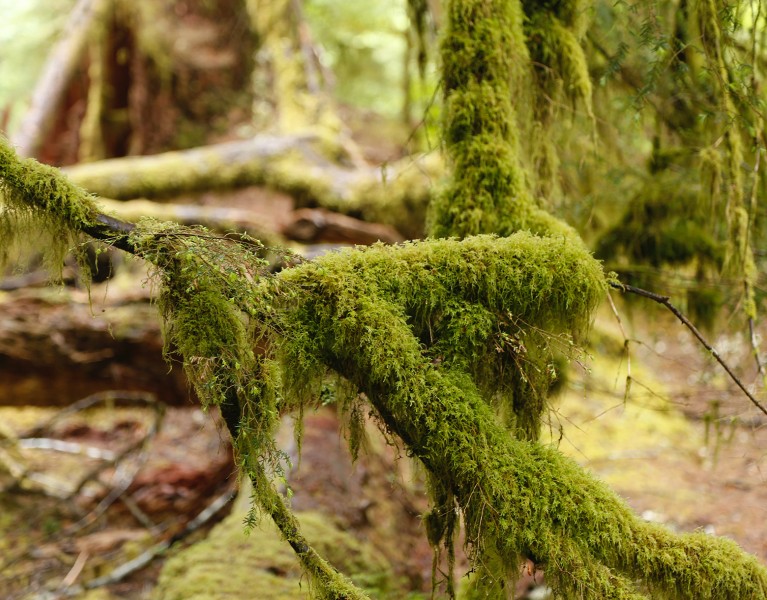
8 Things To Do in Olympic National Park
Table of Contents [Show]
In the far-off, Northwest corner of the state of Washington, you’ll encounter an astonishing natural marvel known today as Olympic National Park. Encompassing nearly one million acres of protected land, it is situated on the rugged Pacific coastline and graced by towering mountains, old-growth trees, rocky beaches, luminous lakes, a moss-covered rainforest, and much more.
The adventures in Olympic National Park may seem endless when you step foot in this ever-expansive region of the country. There’s so much to do, so much to see and so much peace to find in the solitude of nature.
Credited as one of the quietest locations in the continental United States, the verdant region is teeming with an indescribable atmosphere that can only be experienced in person. The area is expansive, but we’ve narrowed down 8 amazing ways to experience the beauty and solitude of Olympic National Park.
Hike into the Mountains
Some of the most spectacular views of the park can be found in the north. You’ll have a defining sight of the mountains and lush green forests below. These trails are well maintained and are most popular in the summer to fall months, though they can be accessed during the winter as well. Just remember to bring your camera, as you won’t find these otherworldly scenes anywhere else in the world.
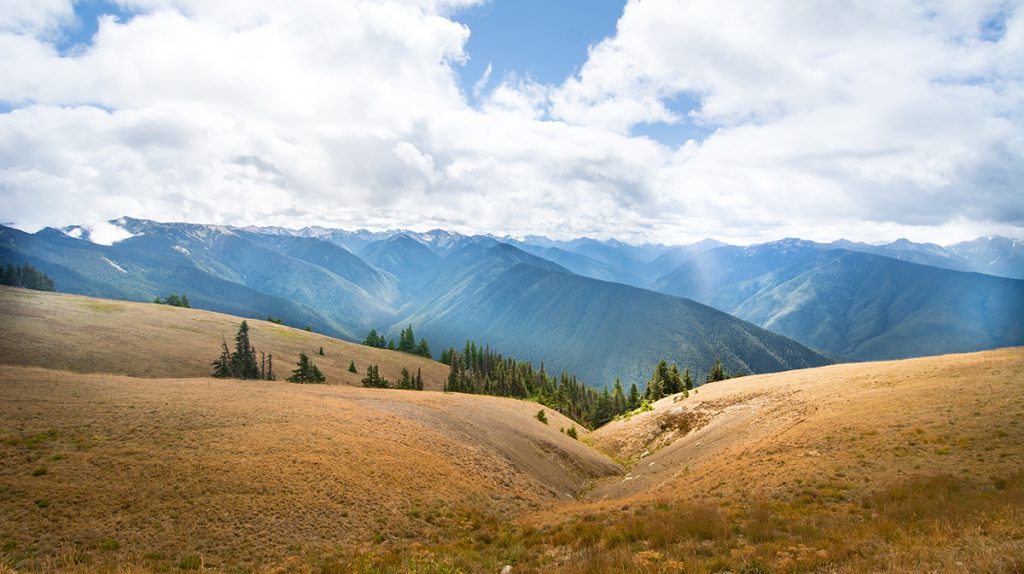
Hurricane Ridge Trail to Hurricane Hill
One of the most popular hikes in this section of Olympic National Park is on Hurricane Ridge. It’s easily accessible, has slow gains in elevation, and ends in an amazing panoramic view of the park. You’ll be able to see vast forests of evergreens, snow-capped mountains, and Mount Olympus. This is a 3.4-mile out-and-back hike and considered easy to moderate. Expect two hours for a round trip.
Sunrise Ridge to Sunrise Point Trail
Another easy to moderate hike in the area is along Sunrise Ridge. This is a tremendous hike for anybody and should belong on your bucket list. The trail leads you up along the mountain range with a breathtaking vista. The trail begins from the Hurricane Ridge parking lot with the trail name changing to Sunrise Point Trail. You’ll end this beautiful hike with a really nice view of Mount Angeles. This is a 3-mile hike, with a total ascent of 800 feet.
Klahhane Ridge Trail to Mount Angeles
This hike is an extension of Sunrise Ridge Trail and is considered a bit more strenuous than the previously mentioned hikes. You’ll hike to the highest peak in the Hurricane Ridge area with one of the best views in the entire park. The trail head can be accessed from the Hurricane Ridge parking lot, as you head east onto Klahhane Ridge Trail (aka Sunrise Ridge Trail). Once you’ve gone beyond Sunrise Ridge you’ll be met with a steep part where you’ll need to do a bit of rock scrambling. This is a 12.5-mile out-and-back hike that may take up to 5 hours, with a total ascent of 4,514 feet.
Mount Ellinor Trail
Not all the amazing mountain hikes are found in the north. Mount Ellinor Trail is a popular out and back trail that is located further south, near Hoodsport, WA. This trail offers sweeping views of the Olympic Mountains, Lake Cushman, and the Puget Sound. There are two different options when deciding to hike this trail. The first is the lower trailhead which is a 6.2-mile out-and-back journey and is considered moderate. The other is the upper trailhead, which requires a Northwest Forest Pass, and is a 3.2-mile trip with super steep switchbacks that will challenge even the most experienced hikers.
Obstruction Point Road
If you’re unable to go on a hike but are looking for some stellar views, then take a drive up Obstruction Point Road. Considered one of Washington’s scariest roads (for its elevation) this gravel path will lead you high up into the mountains where you’ll have an outstanding view of the entire park. Obstruction Point is at an elevation of 6,150 feet and can be accessed from the Hurricane Ridge parking lot.
2. Explore Hoh Rain Forest
If exploring a magical rainforest full of moss-covered trees is on your bucket list, then the Hoh Rain Forest is where you’ll want to be. The only way to explain this enchanted area is like a scene from a fairytale novel. As you walk through the trails, you’ll feel like you may run into a fairy or a faun playing their flute. More likely though, you’ll see Roosevelt Elk, Black Bears, River Otter, and Deer. This temperate rainforest is one of few in the United States and arguably the park's most popular location for visitors. The vibrant green canopy of both coniferous and deciduous trees is the result of an average annual rainfall of 140 inches (11.7 feet). Mosses, ferns, and mushrooms blanket the forest floor, adding an extra dimension to the magic of this forest.
The Hall of Mosses Trail, an iconic loop that takes you through an ancient forest, features a grove of maple trees. The Spruce Nature Trail is a short 1.2-mile loop where you’ll walk alongside Taft Creek. For a grand adventure take the Hoh River Trail, an 18.5-mile hike that ends at Blue Glacier moraine and looks up at Mt. Olympus. There are also plenty of campgrounds in the area that provide you with one of the best places to stay the night in a rainforest. You’ll need to reserve a spot ahead of time here.
3. View the Waterfalls
This enormous park wouldn’t be complete without a few waterfalls. There are some special places you can hike to and enjoy the serenity of the falling water. With so much rain and snowfall each year, these waterfalls are truly a sight to see. Check out these three:
Marymere Falls
With a rather large path that leads you to the majestic Marymere Falls, it’s family-friendly, easily accessible, and full of beauty. This 90-foot waterfall is located along the pristine Lake Crescent providing multiple viewing platforms to soak in the scenery. Various trails surround the area, so there's a lot to explore as well.
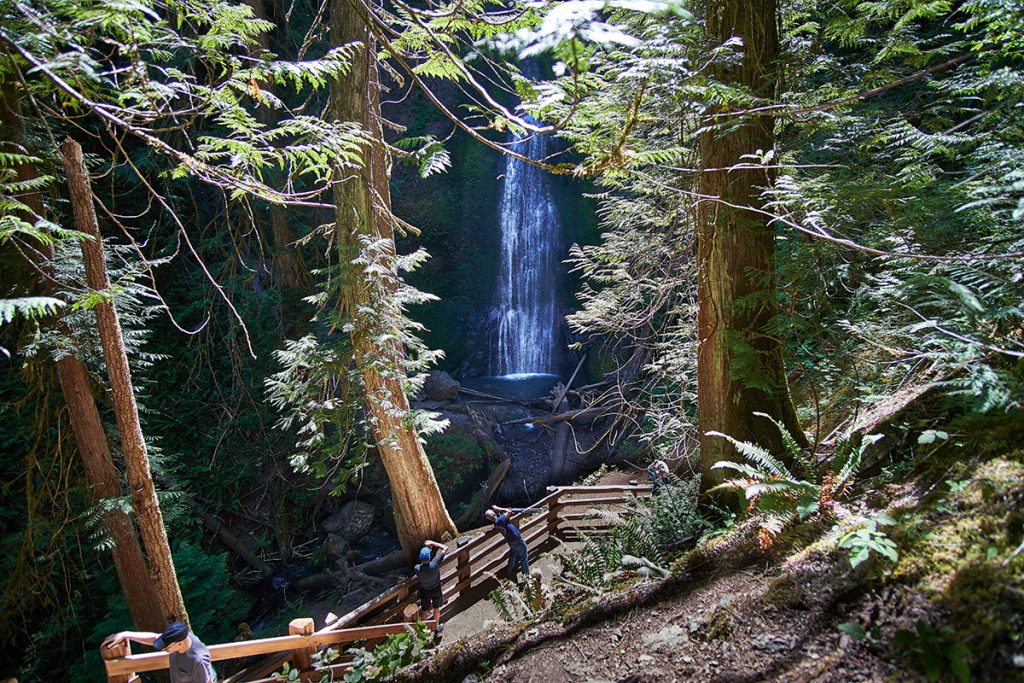
Sol Duc Falls
Within the remote Sol Duc Valley sits the scenic Sol Duc Falls. A simple 2.2-mile round trip from the parking lot will lead you through the moss-covered wonderland where you’ll arrive at a deep box canyon that holds these highly photogenic cascades. This is an easy hike for anyone looking to enjoy waterfalls in Olympic National Park.
Royal Basin Falls
Located in the “rainbow shadow” of the Olympic Mountains is the vivid, but ethereal, Royal Basin Falls. Flowing down from the lakes of the Royal basin, the waterfall sprawls out into different directions, creating an ensemble of multiple small falls over auburn-shaded rocks. Sit here to enjoy the natural music the park has to offer and, when you’re ready, move on to the Royal Basin trail which offers plenty of other amazing sights.
4. Spend Time Around the Lakes and Rivers
If you’re spending more than a few days at Olympic National Park, then you’ll want to visit at least one of the 650 lakes within the enormous park. Some of the alpine lakes require a bit of hiking out into the wilderness, but they also provide you with seclusion and peace of mind. The most popular lakes in the region are Lake Crescent, Lake Ozette, and Lake Cushman where you can enjoy activities such as boating, kayaking, paddleboarding, hiking, and swimming. Or take a short hike to PJ Lake, a spot that’s tucked away around firs, wildflowers, and plenty of wildlife. If you’re in the mood for something more adventurous you could take a backpacking journey to Upper Lena Lake for some peace and quiet.
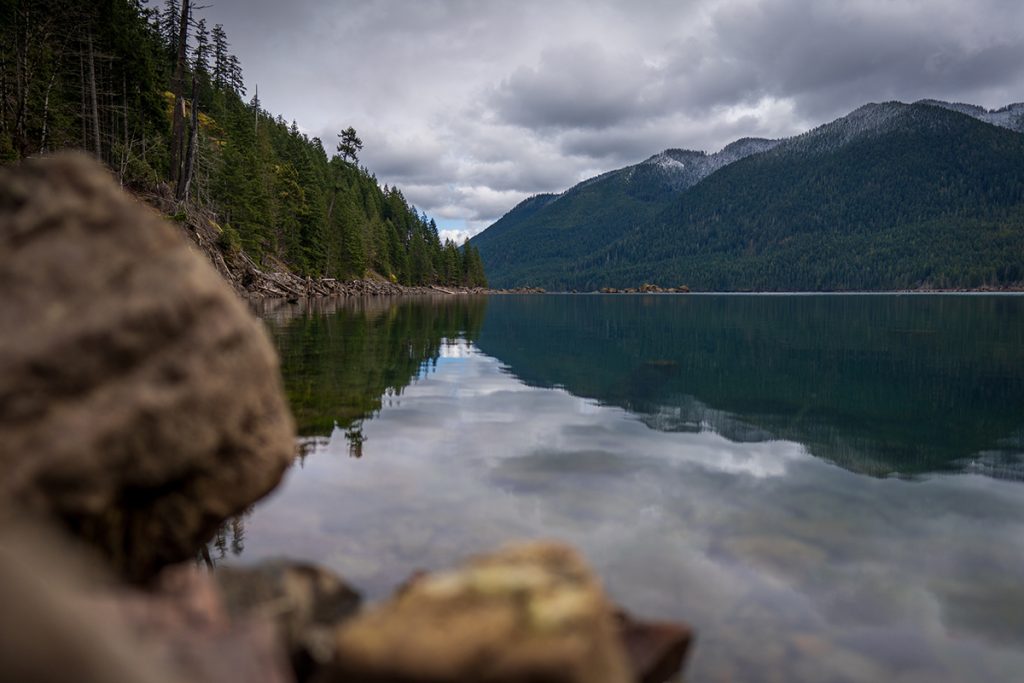
Don’t forget about the 3,500 miles of rivers around this park, too. You can participate in rafting, fishing, and hiking along these protected waters. The Hoh and Quinault rivers are popular attractions that provide visitors with an amazing, well-maintained trail system and rough rapids for a whitewater rafting excursion. The Elwha River is famous for its Dam removal and habitat restoration, a scenic location for a calm river paddle. Visit the Olympic National Park government page to receive information on any regulations, especially if you're into fishing.
5. Bike the Olympic Discovery Trail
Biking the Olympic Discovery Trail is a fantastic way to get a proper full-body workout while having fun and enjoying nature. This trail is designated for non-motorized recreation and has become one of the most popular Olympic National Park attractions in the park. Begin in Port Townsend, then wind through the Peninsula with views of glacier-capped mountains, rushing rivers, vibrant lakes, and end at the Pacific beaches. It’s truly a unique way to experience all that this area has to offer.
6. Visit the Pacific Coastline
The ocean is nearby, so why not add this iconic coastline to your list of places to visit. The beaches are plentiful and you can experience tide pools, interesting rock formations, soaring eagles, sea otters, and possibly a whale sighting. Some of the best beaches in the area include:
Cape Flattery
Located on the Makah Reservation, Cape Flattery is situated on the northernmost point in the contiguous United States, with absolutely stunning views. This is one of the most amazing spots to explore, hike and discover rugged scenery surrounded by a lush forest.
Shi Shi Beach
Shi Shi Beach is one of the most sought out beaches in Olympic National Park. You’ll find swirling tide pools and jagged rock formations along this calm beach. Shi Shi is a great location for a long day hike or an overnight camping trip.
Rialto Beach
Rialto Beach beautifully represents Washington’s craggy coastline. Well known for its giant sea stacks, this beach offers a 4-mile hike where you’ll come across a giant portal known as the Hole-in-the-Wall.
Cape Alava Loop
Nestled within the Olympic National Park in Washington, the Cape Alava Loop offers an exceptional hiking experience along the westernmost point of the contiguous United States. This trail is renowned for its breathtaking coastal views, significant wildlife sightings, and rich historical context, including ancient Native American petroglyphs. If you're visiting during winter, have a look at this backpacking Cape Alava Loop guide.
La Push Beaches
A series of three different beaches line the Pacific shores near the community of La Push. Each one has its own unique setting from the huge rolling waves at the first beach to the large rock formations and gathering birds at the second and third. You’ll also discover an amazing waterfall that plunges directly into the Pacific Ocean known as Strawberry Bay Falls.
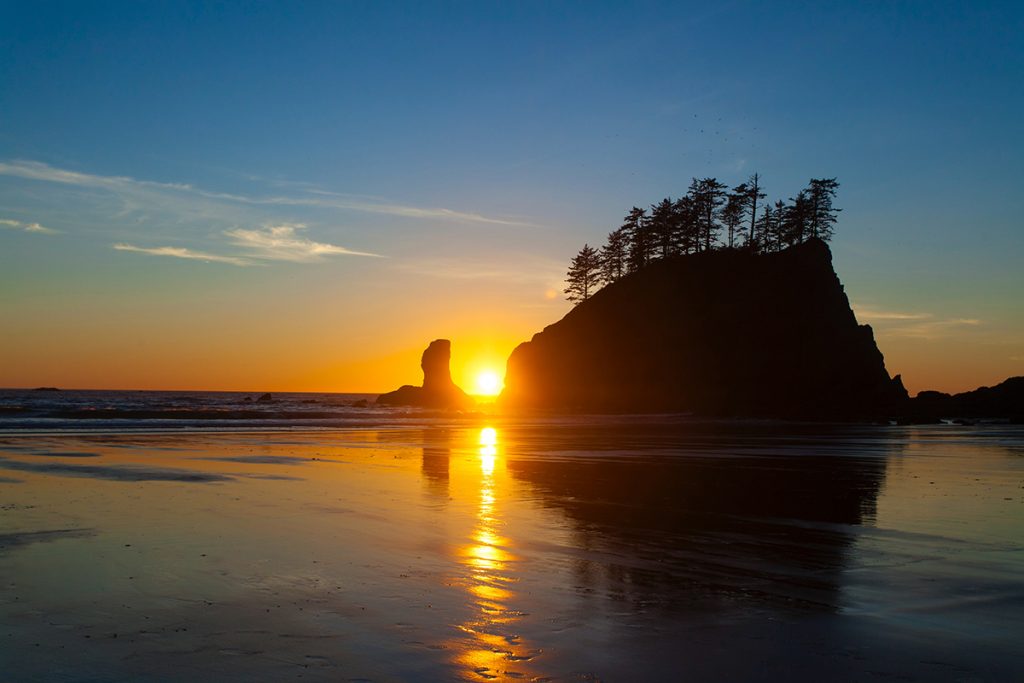
Ruby Beach
Ruby Beach is easily accessible and has terrific coastal views. The name comes from the plethora of ruby-colored crystals within the sand. This is a great option for a sunset stroll along the beach.
Ruby Beach is also one of the dog-friendly spots on the Olympic Peninsula!
Kalaloch
Kalaloch is a well-known beach area with a popular and funky cave to explore called Tree Root Cave. This area is also a great place to stay the night. Kalaloch Lodge offers cabin rentals and campgrounds where you can stay the night and enjoy the fresh, crisp, ocean air.
Some of the beaches are located on tribal lands and may be closed due to COVID-19. To stay updated check the National Park Service website.
7. Go Backpacking
For a once-in-a-lifetime experience, take a backpacking adventure in one of the most mesmerizing national parks in the country. There are plenty of options to explore the vast wilderness - such as backcountry hikes through old-growth forests, rigorous hikes along scenic mountain trails, or a trip down the sandy coastline. Here are a few options:
Enchanted Valley
Permit: Yes, reservations needed
Length: 26-miles round trip
Difficulty: Moderate
The name really speaks for itself. This hike will lead you through some of the most majestic trails in the southern part of Olympic National Park. You’ll be rewarded with amazing mountain views, a variety of wildlife, and a picturesque river valley. Spots are limited, so apply early for a chance to experience this trip.
Seven Lakes Basin Loop (High Divide)
Permit: Yes, reservations needed
Length: 19-miles round trip
Difficulty: Strenuous
This is a high-elevation hike that leads to several different jaw-dropping alpine lakes. This 19-mile hike is located in the northern section of the park and is full of vibrant wildflowers, wandering deer, mountain goats, and black bears who just want to snack on some fresh berries. Oh, and if you’re someone who likes to see the stars at night, you will not be disappointed. To keep this trail protected the forest service limits permits each year, so make sure to reserve your spot early.
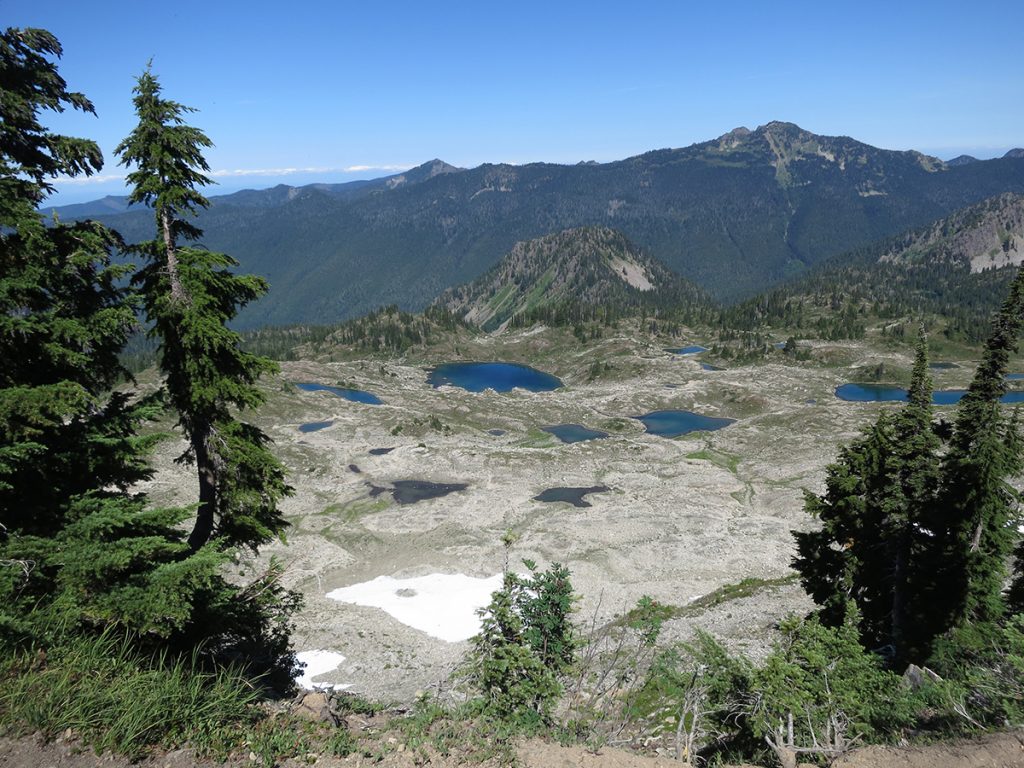
Pacific Coast Wilderness
Permit: Yes, reservations needed
Length: Variable
Difficulty: Moderate with advanced navigation
Take a backpacking journey along the Pacific Coast Wilderness area and sleep near the sea and sandy beaches. The routes vary in length depending on where you begin, with most of the trails non-existent, as you’ll be following the natural land features found along the shore. There are several overhead trails that will aid you in your trip when needed. This hike offers cinematic views of the coastal landscape with challenging terrain such as rocky shores covered by slippery moss, many large driftwood logs, and, of course, the changing tide.
For more information on how to access permits and how you can prepare for these backpacking trips visit the park’s wilderness trip planning site. Check out the backpacking checklist!
8. Stargazing is a Must
In the Olympic National Forest, you’ll discover the brilliance of a glowing night sky in a place unobstructed by light pollution. The feeling of seeing a dark sky covered in glowing stars is unexplainable. On a clear night, you’ll see thousands of stars, galaxies, constellations, and planets. During the summer the park hosts a free astronomy program where you can join a master observer at Hurricane Ridge to learn more about the world beyond our planet. The program also provides telescopes for an up close look into space.
Hurricane Ridge is also one of the most beatiful spots for landscape photography.
Where to Stay in Olympic National Forest
Olympic National Park offers plenty of amazing places to stay, either within the park or just outside in a neighboring city. From campgrounds and beach rentals to hot spring resorts, you’ll find something to suit everybody’s needs.
Port Angeles
Port Angeles is a port town on the Olympic Peninsula and is known as the gateway to the national park. It’s a great place to find everything you need for supplies, as well as a great place to stay the night. If you need a place to park your RV, check out the Salt Creek Recreation RV Park. Or for a charming bed & breakfast, you could reserve a room at Maitland Manor. If you’d like to check into a rustic, yet luxurious hotel, then the Olympic Lodge is a prime choice. Port Angeles is a great town to stay in if you’d like easy access to Hurricane Ridge and Lake Crescent.
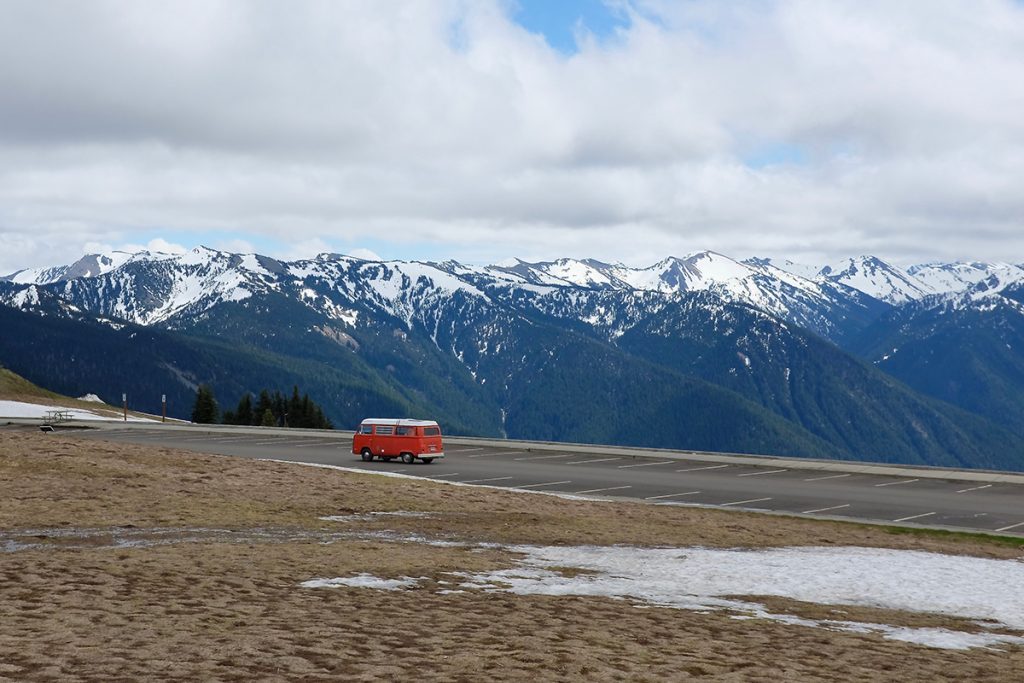
Forks
The town of Forks sits on the Western side of the Olympic Peninsula. This is an excellent starting point to get to the La Push Beaches and the Hoh Rain Forest. The Dew Drop Inn is conveniently located just 30 miles from the Hoh Rain Forest and offers comfortable beds, air conditioning, and free WiFi. For a bit more ambiance, you could book a room at the Quillayute River Resort and relax on the front porch with a beautiful river view.
Campgrounds
There are endless options for Washington State camping in Olympic National Park. The most popular campsites that require reservations are Sol Duc, Mora, Hoh Rainforest, and Kalaloch. Heart O’ the Hills, which is near the Hurricane Ridge trailhead and Fairholme campground, where you’ll have beach access, are on a first-come-first-serve basis. For know-before-you-go information, regulations, and reservation information, check out the National Park Service site.
Embark On an Adventure With KÜHL
Olympic National Park is a generous gem tucked away in the Pacific Northwest. It will provide you with a place of tranquility by connecting you with bountiful nature and beautiful sites. From lush rain forests that hold ancient secrets and waterfalls that sing calming songs to flowing rivers and rugged mountain peaks, Olympic National Park has it all.
This section of the country is where the new, grand adventures await every day. When planning your next trip into the designated wilderness, make sure to acquire the necessary permits and reservations and check regulations. Follow the leave-no-trace principle and always pack out whatever you pack in.
Also, check out Sixteen Vibrant And Authentic National Parks Near Seattle.
Featured image - Hoh Rain Forest by Georg Eiermann.
